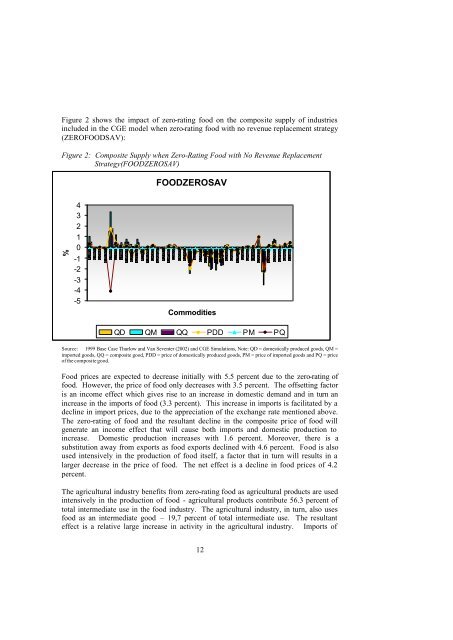Marna Kearney - tips
Marna Kearney - tips
Marna Kearney - tips
Create successful ePaper yourself
Turn your PDF publications into a flip-book with our unique Google optimized e-Paper software.
Figure 2 shows the impact of zero-rating food on the composite supply of industriesincluded in the CGE model when zero-rating food with no revenue replacement strategy(ZEROFOODSAV):Figure 2: Composite Supply when Zero-Rating Food with No Revenue ReplacementStrategy(FOODZEROSAV)FOODZEROSAV%43210-1-2-3-4-5CommoditiesQD QM QQ PDD PM PQSource: 1999 Base Case Thurlow and Van Seventer (2002) and CGE Simulations, Note: QD = domestically produced goods, QM =imported goods, QQ = composite good, PDD = price of domestically produced goods, PM = price of imported goods and PQ = priceof the composite good.Food prices are expected to decrease initially with 5.5 percent due to the zero-rating offood. However, the price of food only decreases with 3.5 percent. The offsetting factoris an income effect which gives rise to an increase in domestic demand and in turn anincrease in the imports of food (3.3 percent). This increase in imports is facilitated by adecline in import prices, due to the appreciation of the exchange rate mentioned above.The zero-rating of food and the resultant decline in the composite price of food willgenerate an income effect that will cause both imports and domestic production toincrease. Domestic production increases with 1.6 percent. Moreover, there is asubstitution away from exports as food exports declined with 4.6 percent. Food is alsoused intensively in the production of food itself, a factor that in turn will results in alarger decrease in the price of food. The net effect is a decline in food prices of 4.2percent.The agricultural industry benefits from zero-rating food as agricultural products are usedintensively in the production of food - agricultural products contribute 56.3 percent oftotal intermediate use in the food industry. The agricultural industry, in turn, also usesfood as an intermediate good – 19,7 percent of total intermediate use. The resultanteffect is a relative large increase in activity in the agricultural industry. Imports of12
















